From Land to Sea, a Review of Hypertemporal Remote Sensing Advances to Support Ocean Surface Science
Abstract
:1. Introduction
- Be univariate in nature (with multiple images of the same parameter only);
- Contain a set of time slices, all of which must be precisely co-registered (with image-to-image pixels perfectly aligned spatially); and
- Exhibit radiometric consistency between images (i.e., they are measured using the same sensors or inter-validated sensor systems, and exhibit a degree of normalisation between time slices).
2. Challenges and Opportunities for Hypertemporal Remote Sensing
3. Avenues to Extract Information from Hypertemporal Earth Observation Datasets
3.1. Pixel-Centred Measurement and Summary Analysis (PMA)
3.2. Principal Components Analysis (PCA)-Founded Approaches
3.3. Classification (CLS)-Founded Approaches
3.4. Time Series Analysis (TSA)-Founded Approaches
4. Adopting a Strategic Approach for Future Advances
- Prioritising data-driven approaches;
- Quantifying temporal signature diversity and ocean surface heterogeneity; and
- Exploiting the unidirectional nature of time.
4.1. Prioritising Data-Driven Approaches
4.2. Quantifying Temporal Signal Diversity and Ocean Surface Heterogeneity
4.3. Exploiting the Unidirectional Nature of Time
5. Conclusions
Author Contributions
Funding
Acknowledgments
Conflicts of Interest
References
- Piwowar, J.M.; LeDrew, E.F. Hypertemporal analysis of remotely sensed sea-ice data for climate change studies. Prog. Phys. Geogr. 1995, 19, 216–242. [Google Scholar] [CrossRef] [Green Version]
- Goodchild, M.F.; Guo, H.; Annoni, A.; Bian, L.; de Bie, K.; Campbell, F.; Craglia, M.; Ehlers, M.; van Genderen, J.; Jackson, D.; et al. Next-generation Digital Earth. Proc. Natl. Acad. Sci. USA 2012, 109, 11088–11094. [Google Scholar] [CrossRef] [PubMed] [Green Version]
- Martin, M.; Dash, P.; Ignatov, A.; Banzon, V.; Beggs, H.; Brasnett, B.; Cayula, J.; Cummings, J.; Donlon, C.; Gentemann, C.; et al. Group for High Resolution Sea Surface temperature (GHRSST) analysis fields inter-comparisons. Part 1: A GHRSST multi-product ensemble (GMPE). Deep Res. Part II 2012, 77–80, 21–30. [Google Scholar] [CrossRef]
- US National Aeronautics and Space Administration MODIS-Aqua Chlorophyll—A Product Description. Available online: https://oceancolor.gsfc.nasa.gov/atbd/chlor_a/ (accessed on 13 September 2019).
- Cavalieri, D.J.; Parkinson, C.L.; Gloersen, P.; Zwally, H.J. Sea Ice Concentrations from Nimbus-7 SMMR and DMSP SSM/I-SSMIS Passive Microwave Data, Version 1. Available online: https://nsidc.org/data/NSIDC-0051/versions/1 (accessed on 11 September 2019).
- Vogelzang, J.; Stoffelen, A. Scatterometer wind vector products for application in meteorology and oceanography. J. Sea Res. 2017, 74, 16–25. [Google Scholar] [CrossRef]
- Jakubaukas, M.E.; Peterson, D.L.; Legates, D. Fourier decomposition of an AVHRR NDVI time-series for seasonal inter-annual landcover change detection. In Analysis of Multi-Temporal Remote Sensing Images; Bruzzone, L., Smits, P., Eds.; World Scientific: Singapore, 2001; p. 456. [Google Scholar]
- Shippert, P. Why Use Hyperspectral Imagery? Photogramm. Eng. Remote Sens. 2004, 70, 377–379. [Google Scholar]
- Kleynhans, W. Detecting Land-Cover Change Using MODIS Time-Series Data. Ph.D. Thesis, University of Pretoria, Pretoria, South Africa, 2011. [Google Scholar]
- Nguyen, T.T.H.; de Bie, C.A.J.M.; Ali, A.; Smaling, E.M.A.; Chu, T.H. Mapping the irrigated rice cropping patterns of the Mekong delta, Vietnam, through hyper-temporal spot NDVI image analysis. Int. J. Remote Sens. 2012, 33, 415–434. [Google Scholar] [CrossRef]
- McCloy, K.R. Resource Management Information Systems: Remote Sensing, GIS and Modelling; Taylor & Francis: Boca Raton, FL, USA, 2006. [Google Scholar]
- Piwowar, J.M.; Peddle, D.R.; Ledrew, E.F. Temporal mixture analysis of Arctic sea ice imagery: A new approach for monitoring environmental change. Remote Sens. Environ. 1998, 63, 195–207. [Google Scholar] [CrossRef]
- de Bie, C.A.J.M.; Khan, R.; Toxopeus, A.G.; Venus, V.; Skidmore, A.K. Hypertemporal image analysis for crop mapping and change detection. In Proceedings of the International Archives of the Photogrammetry, Remote Sensing and Spatial Information Sciences, Beijing, China, 3–11 July 2008; International Society of Photogrammetry and Remote Sensing: Beijing, China, 2008; Volume XXXVII-B7, pp. 803–814. [Google Scholar]
- de Bie, C.A.J.M.; Khan, M.R.; Smakhtin, V.U.; Venus, V.; Weir, M.J.C.; Smaling, E.M.A. Analysis of multi-temporal SPOT NDVI images for small-scale land-use mapping. Int. J. Remote Sens. 2011, 32, 6673–6693. [Google Scholar] [CrossRef]
- Grobler, T.L.; Ackermann, E.R.; Van Zyl, A.J.; Olivier, J.C.; Kleynhans, W.; Salmon, B.P. An inductive approach to simulating multispectral MODIS surface reflectance time series. IEEE Geosci. Remote Sens. Lett. 2013, 10, 446–450. [Google Scholar] [CrossRef]
- Kleynhans, W.; Salmon, B.P.; Wessels, K.J.; Olivier, J.C. Rapid detection of new and expanding human settlements in the Limpopo province of South Africa using a spatio-temporal change detection method. Int. J. Appl. Earth Obs. Geoinf. 2015, 40, 74–80. [Google Scholar] [CrossRef] [Green Version]
- Kleynhans, W.; Salmon, B.P.; Olivier, J.C. Detecting settlement expansion in South Africa using a hyper-temporal SAR change detection approach. Int. J. Appl. Earth Obs. Geoinf. 2015, 42, 142–149. [Google Scholar] [CrossRef]
- Salmon, B.P.; Wessels, K.J.; van den Bergh, F.; Steenkamp, K.; Kleynhans, W.; Swanepoel, D.; Roy, D.; Kovalskyy, V. Evaluation of a rule-based classifier for Landsat-based automated land cover mapping in South Africa. In Proceedings of the IGARSS 2013—2013 IEEE International Geoscience and Remote Sensing Symposium, Melbourne, Australia, 21–26 July 2013; pp. 4301–4304. [Google Scholar]
- Main, R.; Mathieu, R.; Kleynhans, W.; Wessels, K.; Naidoo, L.; Asner, G.P. Hyper-temporal C-band SAR for baseline woody structural assessments in deciduous savannas. Remote Sens. 2016, 8, 661. [Google Scholar] [CrossRef]
- Girma, A.; de Bie, C.A.J.M.; Skidmore, A.K.; Venus, V.; Bongers, F. Hyper-temporal SPOT-NDVI dataset parameterization captures species distributions. Int. J. Geogr. Inf. Sci. 2015, 30, 89–107. [Google Scholar] [CrossRef]
- Pittiglio, C.; Skidmore, A.K.; van Gils, H.A.M.J.; Prins, H.H.T. Identifying transit corridors for elephant using a long time-series. Int. J. Appl. Earth Obs. Geoinf. 2012, 14, 61–72. [Google Scholar] [CrossRef]
- Pittiglio, C.; Skidmore, A.K.; Van Gils, H.A.; Prins, H.H. Elephant response to spatial heterogeneity in a savanna landscape of northern Tanzania. Ecography 2013, 36, 819–831. [Google Scholar] [CrossRef]
- Jiang, Y.; de Bie, C.A.J.M.; Wang, T.; Skidmore, A.K.; Liu, X.; Song, S.; Shao, X. Hyper-temporal remote sensing helps in relating epiphyllous liverworts and evergreen forests. J. Veg. Sci. 2013, 24, 214–226. [Google Scholar] [CrossRef]
- Beck, P.S.A.; Jönsson, P.; Høgda, K.A.; Karlsen, S.R.; Eklundh, L.; Skidmore, A.K. A ground-validated NDVI dataset for monitoring vegetation dynamics and mapping phenology in Fennoscandia and the Kola peninsula A ground-validated NDVI dataset for monitoring vegetation dynamics and mapping phenology in Fennoscandia and the Kola peninsula. Int. J. Remote Sens. 2007, 2819, 4311–4330. [Google Scholar] [CrossRef]
- O’Connor, B.; Dwyer, E.; Cawkwell, F.; Eklundh, L. Spatio-temporal patterns in vegetation start of season across the island of Ireland using the MERIS Global Vegetation Index. ISPRS J. Photogramm. Remote Sens. 2012, 68, 79–94. [Google Scholar] [CrossRef]
- Tan, W.; LeDrew, E. Monitoring Arctic sea ice phenology change using hypertemporal remotely sensed data: 1989–2010. Theor. Appl. Climatol. 2016, 125, 353–363. [Google Scholar] [CrossRef]
- Beck, P.S.A.; Wang, T.J.; Skidmore, A.K.; Liu, X.H. Displaying remotely sensed vegetation dynamics along natural gradients for ecological studies. Int. J. Remote Sens. 2008, 29, 4277–4283. [Google Scholar] [CrossRef]
- Ali, A.; de Bie, C.A.J.M.; Skidmore, A.K.; Scarrott, R.G.; Hamad, A.; Venus, V.; Lymberakis, P. Mapping land cover gradients through analysis of hyper-temporal NDVI imagery. Int. J. Appl. Earth Obs. Geoinf. 2013, 23, 301–312. [Google Scholar] [CrossRef]
- Wessels, K.; Steenkamp, K.; Von Maltitz, G.; Archibald, S. Remotely sensed vegetation phenology for describing and predicting the biomes of South Africa. Appl. Veg. Sci. 2011, 14, 49–66. [Google Scholar] [CrossRef]
- Ali, A.; de Bie, C.A.J.M.; Skidmore, A.K. Detecting long-duration cloud contamination in hyper-temporal NDVI imagery. Int. J. Appl. Earth Obs. Geoinf. 2013, 24, 22–31. [Google Scholar] [CrossRef]
- Okkonen, S.R.; Weingartner, T.J.; Danielson, S.L.; Musgrave, D.L.; Schmidt, G.M. Satellite and hydrographic observations of eddy-induced shelf-slope exchange in the northwestern Gulf of Alaska. J. Geophys. Res. Oceans 2003, 108. [Google Scholar] [CrossRef]
- LeDrew, E. The temporal signal of sea ice variability in the Polar Basin from wavelet analysis of passive microwave sea ice concentrations. In Proceedings of the International Workshop on the Analysis of Multi-Temporal Remote Sensing Images, Biloxi, MS, USA, 16–18 May 2005; IEEE: Piscataway, NJ, USA, 2005; pp. 182–183. [Google Scholar]
- Ji, R.; Jin, M.; Varpe, Ø. Sea ice phenology and timing of primary production pulses in the Arctic Ocean. Glob. Chang. Biol. 2013, 19, 734–741. [Google Scholar] [CrossRef] [PubMed]
- Le Traon, D.; Antoine, D.; Bentamy, A.; Bonekamp, H.; Breivik, L.; Chapron, B.; Corlett, G.; Diharboure, G.; DiGiacomo, P.; Donlon, C.; et al. Use of satellite observations for operational oceanography: Recent achievements and future prospects. J. Oper. Oceanogr. 2015, 8, s12–s27. [Google Scholar] [CrossRef]
- Lalli, C.; Parsons, T. Biological Oceanography: An Introduction, 2nd ed.; Elsevier Ltd.: Amsterdam, The Netherlands, 1997; ISBN 9780750633840. [Google Scholar]
- USA National Phenology Network Database. Available online: https://www.usanpn.org/data (accessed on 31 July 2019).
- Pan-European Phenology Database. Available online: http://www.pep725.eu/statistics.php (accessed on 31 July 2019).
- Dai, J.; Wang, H.; Ge, Q. The spatial pattern of leaf phenology and its response to climate change in China. Int. J. Biometeorol. 2014, 58, 521–528. [Google Scholar] [CrossRef]
- Racault, M.; Le, C.; Buitenhuis, E.; Sathyendranath, S.; Platt, T. Phytoplankton phenology in the global ocean. Ecol. Indic. 2012, 14, 152–163. [Google Scholar] [CrossRef]
- Eliasen, S.K.; Hátún, H.; Larsen, K.M.H.; Jacobsen, S. Faroe shelf bloom phenology—The importance of ocean-to-shelf silicate fl uxes. Cont. Shelf Res. 2017, 143, 43–53. [Google Scholar] [CrossRef]
- Rixen, T.; Haake, B.; Ittekkot, V.; Guptha, M.V.S.; Nair, R.R.; Schlüssel, P. Coupling between SW monsoon-related surface and deep ocean processes as discerned from continuous particle flux measurements and correlated satellite data. J. Geophys. Res. 1996, 101, 28569–28582. [Google Scholar] [CrossRef]
- Thomas, A.C.; Weatherbee, R.A. Satellite-measured temporal variability of the Columbia River plume. Remote Sens. Environ. 2006, 100, 167–178. [Google Scholar] [CrossRef]
- Prospero, J.M.; Barrett, K.; Church, T.; Dentener, F.; Duce, R.A.; Galloway, J.N.; Ii, H.L.; Moody, J.; Quinn, P. Atmospheric deposition of nutrients to the North Atlantic Basin. Biogeochemistry 1996, 35, 27–73. [Google Scholar] [CrossRef]
- Michaels, A.F.; Olson, D.; Sarmiento, J.L. Inputs, losses and transformations of nitrogen and phosphorus in the pelagic North Atlantic Ocean. Biogeochemistry 1996, 35, 181–226. [Google Scholar] [CrossRef]
- Krug, L.A.; Platt, T.; Sathyendranath, S.; Barbosa, A.B. Ocean surface partitioning strategies using ocean colour remote Sensing: A review. Prog. Oceanogr. 2017, 155, 41–53. [Google Scholar] [CrossRef]
- Ali, A.; de Bie, C.A.J.M.; Skidmore, A.K.; Scarrott, R.G.; Lymberakis, P. Mapping the heterogeneity of natural and semi-natural landscapes. Int. J. Appl. Earth Obs. Geoinf. 2014, 26, 176–183. [Google Scholar] [CrossRef]
- Santos, A.M.P. Fisheries oceanography using satellite and airborne remote sensing methods: A review. Fish. Res. 2000, 49, 1–20. [Google Scholar] [CrossRef]
- Nieto, K.; Xu, Y.; Teo, S.L.H.; McClatchie, S.; Holmes, J. How important are coastal fronts to albacore tuna (Thunnus alalunga) habitat in the Northeast Pacific Ocean? Prog. Oceanogr. 2017, 150, 62–71. [Google Scholar] [CrossRef]
- Piwowar, J.M. An Environmental Normal of Vegetation Vigour for the Northern Great Plains. IEEE J. Sel. Top. Appl. Earth Obs. Remote Sens. 2011, 4, 292–302. [Google Scholar] [CrossRef]
- Piwowar, J.M. The derivation of an Arctic sea ice normal through temporal mixture analysis of satellite imagery. Int. J. Appl. Earth Obs. Geoinf. 2008, 10, 92–108. [Google Scholar] [CrossRef]
- Derksen, C.; Wulder, M.; LeDrew, E.; Goodison, B. Associations between spatially autocorrelated patterns of SSM/I-derived prairie snow cover and atmospheric circulation. Hydrol. Process. 1998, 12, 2307–2316. [Google Scholar] [CrossRef]
- Derksen, C.; LeDrew, E.; Goodison, B. Ssm/i derived snow water equivalent data: The potential for investigating linkages between snow cover and atmospheric circulation. Atmos. Ocean 1998, 36, 95–117. [Google Scholar] [CrossRef]
- Piwowar, J.M.; Derksen, C.P. Spatial-temporal variability of Northern Hemisphere sea ice concentrations and concurrent atmospheric teleconnections. J. Environ. Inform. 2008, 11, 103–122. [Google Scholar] [CrossRef]
- Kleynhans, W.; Olivier, J.C.; Salmon, B.P.; Wessels, K.J.; van den Bergh, F. A spatio-temporal approach to detecting land cover change using an extended kalman filter on modis time series data. In Proceedings of the IGARSS 2010—2010 IEEE International Geoscience and Remote Sensing Symposium, Honolulu, HI, USA, 25–30 July 2010; pp. 1972–1975. [Google Scholar]
- Salmon, B.P.; Olivier, J.C.; Wessels, K.J.; Kleynhans, W.; van den Bergh, F.; Steenkamp, K.C. Unsupervised Land Cover Change Detection: Meaningful Sequential Time Series Analysis. IEEE J. Sel. Top. Appl. Earth Obs. Remote Sens. 2011, 4, 327–335. [Google Scholar] [CrossRef]
- Ali, A.; de Bie, C.A.J.M.; Scarrott, R.G.; Ha, N.T.T.; Skidmore, A.K. Comparative Performance Analysis of a Hyper-Temporal Ndvi Analysis Approach and a Landscape-Ecological Mapping Approach. ISPRS Ann. Photogramm. Remote Sens. Spat. Inf. Sci. 2012, I-7, 105–110. [Google Scholar] [CrossRef]
- de Bie, C.A.J.M.; Nguyen, T.T.H.; Ali, A.; Scarrott, R.; Skidmore, A.K. LaHMa: A landscape heterogeneity mapping method using hyper-temporal datasets. Int. J. Geogr. Inf. Sci. 2012, 26, 2177–2192. [Google Scholar] [CrossRef]
- Grobler, T.L. Sequential and Non-Sequential Hypertemporal Classification and Change Detection of MODIS Time-Series. Ph.D. Thesis, University of Pretoria, Pretoria, South Africa, 2012. [Google Scholar]
- Wessels, K.J.; van den Bergh, F.; Scholes, R.J. Limits to detectability of land degradation by trend analysis of vegetation index data. Remote Sens. Environ. 2012, 125, 10–22. [Google Scholar] [CrossRef]
- Oindo, B.O.; de By, R.A.; Skidmore, A.K. Interannual variability of NDVI and bird species diversity in Kenya. JAG 2000, 2, 172–180. [Google Scholar] [CrossRef]
- Oindo, B.O.; Skidmore, A.K. Interannual variability of NDVI and species richness in Kenya. Int. J. Remote Sens. 2002, 23, 285–298. [Google Scholar] [CrossRef] [Green Version]
- Kleynhans, W.; Salmon, B.P.; Olivier, J.C.; Van Den Bergh, F.; Wessels, K.J.; Grobler, T.L.; Steenkamp, K.C. Land cover change detection using autocorrelation analysis on MODIS time-series data: Detection of new human settlements in the gauteng province of South Africa. IEEE J. Sel. Top. Appl. Earth Obs. Remote Sens. 2012, 5, 777–783. [Google Scholar] [CrossRef]
- Lunetta, R.S.; Knight, J.F.; Ediriwickrema, J.; Lyon, J.G.; Worthy, L.D. Land-cover change detection using multi-temporal MODIS NDVI data. Remote Sens. Environ. 2006, 105, 142–154. [Google Scholar] [CrossRef]
- Eastman, J.R.; Fulk, M. Evaluation Time Series Long Sequence Gomponents Principal Standardized Using. Photogramm. Eng. Remote Sens. 1993, 59, 991–996. [Google Scholar]
- Liu, J.-G.; Mason, P.J. Image Processing and GIS for Remote Sensing: Techniques and Applications; John Wiley & Sons: Chichester, UK, 2016. [Google Scholar]
- Derksen, C.; LeDrew, E.; Goodison, B. Temporal and spatial variability of North American prairie snow cover (1988–1995) inferred from passive microwave- derived snow water equivalent imagery. Water Resour. Res. 2000, 36, 255–266. [Google Scholar] [CrossRef]
- Lasaponara, R. Estimating Interannual Variations in Vegetated Areas of Sardinia Island Using SPOT/VEGETATION NDVI Temporal Series. IEEE Geosci. Remote Sens. Lett. 2006, 3, 481–483. [Google Scholar] [CrossRef]
- Udelhoven, T.; van der Linden, S.; Waske, B.; Stellmes, M.; Hoffmann, L. Hypertemporal Classification of Large Areas Using Decision Fusion. IEEE Geosci. Remote Sens. Lett. 2009, 6, 592–596. [Google Scholar] [CrossRef]
- Derksen, C.; Walker, A.; LeDrew, E.; Goodison, B. Combining SMMR and SSM/I Data for Time Series Analysis of Central North American Snow Water Equivalent. J. Hydrometeorol. 2003, 4, 304–316. [Google Scholar] [CrossRef]
- Piwowar, J.M.; Ledrew, E.F. Principal components analysis of arctic ice conditions between 1978 and 1987 as observed from the SMMR data record. Can. J. Remote Sens. 1996, 22, 390–403. [Google Scholar] [CrossRef]
- Piwowar, J.M.; Derksen, C.P.; Ledrew, E.F. Principal Components Analysis of the Variability of Northern Hemisphere Sea Ice Concentrations: 1979–1999. In Proceedings of the 23rd Canadian Symposium on Remote Sensing/10e Congrès de L’Association Québécoise de Télédetection, Sainte-Foy, QC, Canada, 21–24 August 2001; Canadian Remote Sensing Society: Ottawa, ON, Canada, 2001; pp. 619–628. [Google Scholar]
- Boardman, J.W.; Kruse, F.A.; Green, R.O. Mapping target signatures via partial unmixing of AVIRIS data, North Grapevine Mountains Nevada. In Proceedings of the 10th Thematic Conference on Geologic Remote Sensing, San Antonio, TX, USA, 9–12 May 1994; Environmental Research Institute of Michigan: Ann Arbor, MI, USA, 1995; Volume 1, pp. 407–418. [Google Scholar]
- Scarrott, R.G. Extracting Gradient Boundaries Using Hyper-Temporal Image Analysis: Progress towards a Tool for Gradient Analysts. Ph.D. Thesis, University of Southampton, Southampton, UK, Lund University, Lund, Sweden, University of Warsaw, Warsaw, Poland, International Institute for Geo-Information Science and Earth Observation (ITC), Enschede, The Netherlands, 2009. [Google Scholar]
- Chuvieco, E.; Heute, A. Fundamentals of Satellite Remote Sensing; CRC Press: Boca Raton, FL, USA, 2010; ISBN 9780415310840. [Google Scholar]
- de Bie, C.A.J.M. Spatial-temporal mapping of agro-ecosystems and the need to build thematic legends. In Proceedings of the XXth ISPRS Congress, Geo-Imagery Bridging Continents, Istanbul, Turkey, 12–23 July 2004; Commission VII Papers. International Society of Photogrammetry and Remote Sensing: Istanbul, Turkey, 2004; pp. 1–7. [Google Scholar]
- Salmon, B.P.; Kleynhans, W.; Van Den Bergh, F.; Olivier, J.C.; Marais, W.J.; Grobler, T.L.; Wessels, K.J. A search algorithm to meta-optimize the parameters for an Extended Kalman filter to improve classification on hyper-temporal images. In Proceedings of the 2012 IEEE International Geoscience and Remote Sensing Symposium, Munich, Germany, 22–27 July 2012; pp. 4974–4977. [Google Scholar]
- Ackermann, E.R.; Grobler, T.L.; van Zyl, A.J.; Steenkamp, K.C.; Olivier, J.C. Minimum Error Land Cover Separability Analysis and Classification. In Proceedings of the IGARSS 2011—2011 IEEE International Geoscience and Remote Sensing Symposium, Vancouver, BC, Canada, 24–29 July 2011; Volume 2, pp. 2999–3002. [Google Scholar]
- Grobler, T.L.; Ackermann, E.R.; van Zyl, A.J.; Kleynhans, W.; Salmon, B.P.; Olivier, J.C. Sequential classification of MODIS time-series. In Proceedings of the IGARSS 2012—2012 IEEE International Geoscience and Remote Sensing Symposium, Munich, Germany, 22–27 July 2012; pp. 6236–6239. [Google Scholar]
- Schowengert, R.A. Remote Sensing: Models and Methods for Image Processing, 2nd ed.; Academic Press: San Diego, CA, USA, 1997. [Google Scholar]
- Jensen, J.R. Introductory Digital Image Processing: A Remote Sensing Perspective, 3rd ed.; Pearson Prentice Hall: Upper Saddle River, NJ, USA, 2005. [Google Scholar]
- Khan, M.R.; de Bie, C.A.J.M.; van Keulen, H.; Smaling, E.M.A.; Real, R. Disaggregating and mapping crop statistics using hypertemporal remote sensing. Int. J. Appl. Earth Obs. Geoinf. 2010, 12, 36–46. [Google Scholar] [CrossRef]
- Li, H.; Reynolds, J.F. On Definition and Quantification of Heterogeneity. Oikos 1995, 73, 280–284. [Google Scholar] [CrossRef]
- Olivier, J.C.; Wessels, K.J.; Araya, S. Detection of Land Cover Change Using an Artificial Neural Network Within a Temporal Sliding Window on Modis Time Series Data. In Proceedings of the IGARSS 2008—2008 IEEE International Geoscience and Remote Sensing Symposium, Boston, MA, USA, 7–11 July 2008; pp. 8–9. [Google Scholar]
- Salmon, B.P.; Olivier, J.C.; Kleynhans, W.; Wessels, K.J.; van den Bergh, F.; Steenkamp, K.C. The use of a Multilayer Perceptron for detecting new human settlements from a time series of MODIS images. Int. J. Appl. Earth Obs. Geoinf. 2011, 13, 873–883. [Google Scholar] [CrossRef] [Green Version]
- Salmon, B.P.; Kleynhans, W.; van den Bergh, F.; Olivier, J.C.; Marais, W.J.; Grobler, T.L.; Wessels, K.J. Meta-Optimization of the Extended Kalman Filter’s Parameters Through the Use of the Bias Variance Equilibrium Point Criterion. IEEE Trans. Geosci. Remote Sens. 2014, 52, 5072–5087. [Google Scholar] [CrossRef]
- Piwowar, J.M.; LeDrew, E.F. On the Autoregressive Nature of Arctic Sea Ice Concentrations. Can. J. Remote Sens. 2001, 27, 517–525. [Google Scholar] [CrossRef]
- Hipel, K.; McLeod, A. Time Series Modelling of Water Resources and Environmental Systems; Elsevier: Amsterdam, The Netherlands, 1994. [Google Scholar]
- Piwowar, J.M.; Ledrew, E.F. ARMA time series modelling of remote sensing imagery: A new approach for climate change studies. Int. J. Remote Sens. 2002, 23, 5225–5248. [Google Scholar] [CrossRef]
- Piwowar, J.M.; Wessel, G.R.I.; LeDrew, E.F. Image Time Series Analysis of Arctic Sea Ice. In Proceedings of the Geoscience and Remote Sensing Symposium, IGARSS ’96, Remote Sensing for a Sustainable Future, Lincoln, NE, USA, 31 May 1996; IEEE: Piscataway, NJ, USA, 1996; pp. 645–647. [Google Scholar]
- Fensholt, R.; Langanke, T.; Rasmussen, K.; Reenberg, A.; Prince, S.D.; Tucker, C.; Scholes, R.J.; Le, Q.B.; Bondeau, A.; Eastman, R.; et al. Greenness in semi-arid areas across the globe 1981–2007—An Earth Observing Satellite based analysis of trends and drivers. Remote Sens. Environ. 2012, 121, 144–158. [Google Scholar] [CrossRef]
- Anderson, M.R.; Drobot, S.D. Arctic ocean snow melt onset dates derived from passive microwave: A new data set. In Report GD-30: Monitoring an Evolving Cryosphere—Summary of the NSIDC Special Session at the American Geophysical Union Fall Meeting 2001; Mullins, T., Naranjo, L., Yohe, L., Eds.; National Snow and Ice Data Centre: Boulder, CO, USA, 2002; pp. 13–17. ISBN 981-02-4955-1. [Google Scholar]
- Menenti, M.; Azzali, S.; Verhoef, W.; Vanswol, R. Mapping agroecological zones and time-lag in vegetation growth by means of fourier-analysis of time-series of ndvi images. Adv. Space Res. 1993, 13, 233–237. [Google Scholar] [CrossRef]
- Shariatinajafabadi, M.; Wang, T.; Skidmore, A.K.; Toxopeus, A.G.; Kölzsch, A.; Nolet, B.A.; Exo, K.M.; Griffin, L.; Stahl, J.; Cabot, D. Migratory herbivorous waterfowl track satellite-derived green wave index. PLoS ONE 2014, 9, e108331. [Google Scholar] [CrossRef]
- Zeng, Z.G.; Beck, P.S.; Wang, T.J.; Skidmore, A.K.; Song, Y.L.; Gong, H.S.; Prins, H.H. Effects of plant phenology and solar radiation on seasonal movement of golden takin in the Qinling Mountains, China Effects of plant phenology and solar radiation on seasonal movement of golden takin in the Qinling Mountains, China. J. Mammal. 2010, 91, 92–100. [Google Scholar] [CrossRef]
- Jiang, Y.; Wang, T.; De Bie, C.A.J.M.; Skidmore, A.K.; Liu, X.; Song, S.; Zhang, L.; Wang, J.; Shao, X. Satellite-derived vegetation indices contribute significantly to the prediction of epiphyllous liverworts. Ecol. Indic. 2014, 38, 72–80. [Google Scholar] [CrossRef]
- Rabiner, L.R.; Juang, B.H. An introduction to hidden markov models. IEEE ASSP Mag. 1986, 3, 4–16. [Google Scholar] [CrossRef]
- Hoff, J.C. A Practical Guide to Box-Jenkins Forecasting; Lifetime Learning Publications: Belmont, CA, USA, 1983. [Google Scholar]
- Reed, B.C.; Brown, J.F.; Van der Zee, D.; Loveland, T.R.; Merchant, J.W.; Ohlen, D.O.; Bradley, C.; Jesslyn, F.; Thomas, R.; James, W.; et al. Measuring Phenological Variability from Satellite Imagery. J. Veg. Sci. 1994, 5, 703–714. [Google Scholar] [CrossRef]
- Canisius, F.; Turral, H.; Molden, D. Fourier analysis of historical NOAA time series data to estimate bimodal agriculture. Int. J. Remote Sens. 2007, 28, 5503–5522. [Google Scholar] [CrossRef]
- Salmon, B.P.; Olivier, J.C.; Kleynhans, W.; Wessels, K.J. A modified temporal approach to meta-optimizing an Extended Kalman Filters parameters. In Proceedings of the IGARSS 2014—2014 IEEE International Geoscience and Remote Sensing Symposium, Quebec City, QC, Canada, 13–18 July 2014; pp. 4224–4227. [Google Scholar]
- Jönsson, P.; Eklundh, L. Seasonality Extraction by Function Fitting to Time-Series of Satellite Sensor Data. IEEE Trans. Geosci. Remote Sens. 2002, 40, 1824–1832. [Google Scholar] [CrossRef]
- Jönsson, P.; Eklundh, L. TIMESAT—A program for analyzing time-series of satellite sensor data. Comput. Geosci. 2004, 30, 833–845. [Google Scholar] [CrossRef]
- Mitra, S. Digital Signal Processing; Stephen, W., Ed.; McGraw-Hill: New York, NY, USA, 2002. [Google Scholar]
- Lhermitte, S.; Verbesselt, J.; Jonckheere, I.; Nackaerts, K.; van Aardt, J.A.; Verstraeten, W.W.; Coppin, P. Hierarchical image segmentation based on similarity of NDVI time series. Remote Sens. Environ. 2008, 112, 506–521. [Google Scholar] [CrossRef]
- Verhoef, W.; Menenti, M.; Azzali, S. A colour composite of NOAA-AVHRR-NDVI based on time series analysis (1981–1992). Int. J. Remote Sens. 1996, 17, 231–235. [Google Scholar] [CrossRef]
- Holloway, D. Accurate temporal resolution of harmonic content in both amplitude and phase. Anziam J. 2014, 55, C235–C249. [Google Scholar] [CrossRef]
- Kleynhans, W.; Olivier, K.C.; Wessels, K.J.; van den Bergh, F.; Salmon, B.P.; Steenkamp, K.C. Improving land cover class separation using an extended kalman filter on MODIS NDVI time-series data. IEEE Geosci. Remote Sens. Lett. 2010, 7, 381–385. [Google Scholar] [CrossRef]
- Kleynhans, W.; Olivier, J.C.; Salmon, B.P.; Wessels, K.J.; van den Bergh, F. Improving NDVI time series class separation using an Extended Kalman Filter. In Proceedings of the IGARSS 2009—2009 IEEE International Geoscience and Remote Sensing Symposium, Cape Town, South Africa, 12–17 July 2009; pp. 256–259. [Google Scholar]
- Viovy, N.; Saint, G. Hidden Markov Models applied to vegetation dynamics analysis using satellite remote sensing. IEEE Trans. Geosci. Remote Sens. 1994, 32, 906–917. [Google Scholar] [CrossRef]
- Yuan, Y.; Meng, Y.; Lin, L.; Sahli, H.; Yue, A.; Chen, J. Continuous Change Detection and Classification Using Hidden Markov Model: A Case Study for Monitoring Urban Encroachment onto Farmland in Beijing. Remote Sens. 2015, 7, 15318–15339. [Google Scholar] [CrossRef] [Green Version]
- Piwowar, J.M.; Peddle, D.R.; LeDrew, E.F. Temporal Mixture Analysis of SMMR Sea Ice Concentrations. In Proceedings of the Geoscience and Remote Sensing Symposium, IGARSS ’96, Remote Sensing for a Sustainable Future, Lincoln, NE, USA, 31 May 1996; IEEE: Piscataway, NJ, USA, 1996; pp. 938–940. [Google Scholar]
- O’Connor, B.; Scarrott, R.; Dwyer, N. Use of Remote Sensing in Phenological Research in Ireland. In Climate Change Impacts on Phenology: Implications for Terrestrial Ecoystems. Climate Change Research Programme (CCRP) 2007–2013 Report Series No. 22; Donnelly, A., O’Neill, B., Eds.; (IE) Environmental Protection Agency: Johnstown Castle, Ireland, 2013; pp. 35–39. ISBN 978-1-84095-463-0. [Google Scholar]
- Lieth, H. Purposes of a Phenology Book. In Phenology and Seasonality Modeling; Lieth, H., Ed.; Springer: New York, NY, USA, 1974; pp. 3–19. [Google Scholar]
- Justice, C.O.; Townshend, J.R.G.; Holben, A.N.; Tucker, C.J. Analysis of the phenology of global vegetation using meteorological satellite data. Int. J. Remote Sens. 1985, 6, 1271–1318. [Google Scholar] [CrossRef]
- Anees, A.; Oliver, J. Detecting Beetle Infestations in Pine Forest Using MODIS NDVI Time-series Data. In Proceedings of the IGARSS 2013—2013 IEEE International Geoscience and Remote Sensing Symposium, Melbourne, Australia, 21–26 July 2013; pp. 3329–3332. [Google Scholar]
- Kleynhans, W.; Salmon, B.P.; Olivier, J.C.; van den Bergh, F.; Wessels, K.J.; Grobler, T. Detecting land cover change using a sliding window temporal autocorrelation approach. In Proceedings of the IGARSS 2012—2012 IEEE International Geoscience and Remote Sensing Symposium, Munich, Germany, 22–27 July 2012; pp. 6765–6768. [Google Scholar]
- Salmon, B.P.; Kleynhans, W.; Schwegmann, C.P.; Olivier, J.C. Proper comparison among methods using a confusion matrix. In Proceedings of the IGARSS 2015—2015 IEEE International Geoscience and Remote Sensing Symposium, Milan, Italy, 13–18 July 2015; pp. 3057–3060. [Google Scholar]
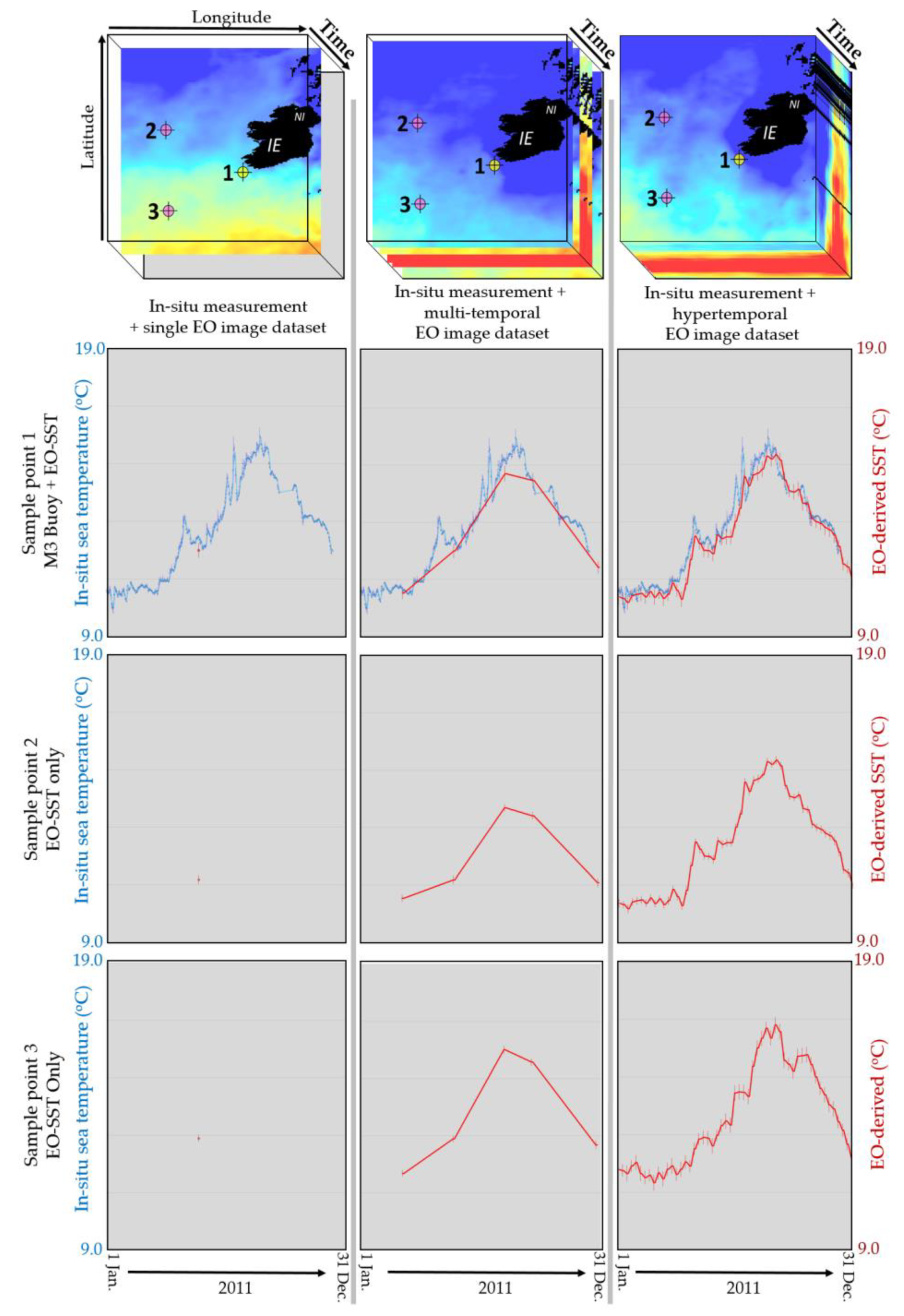
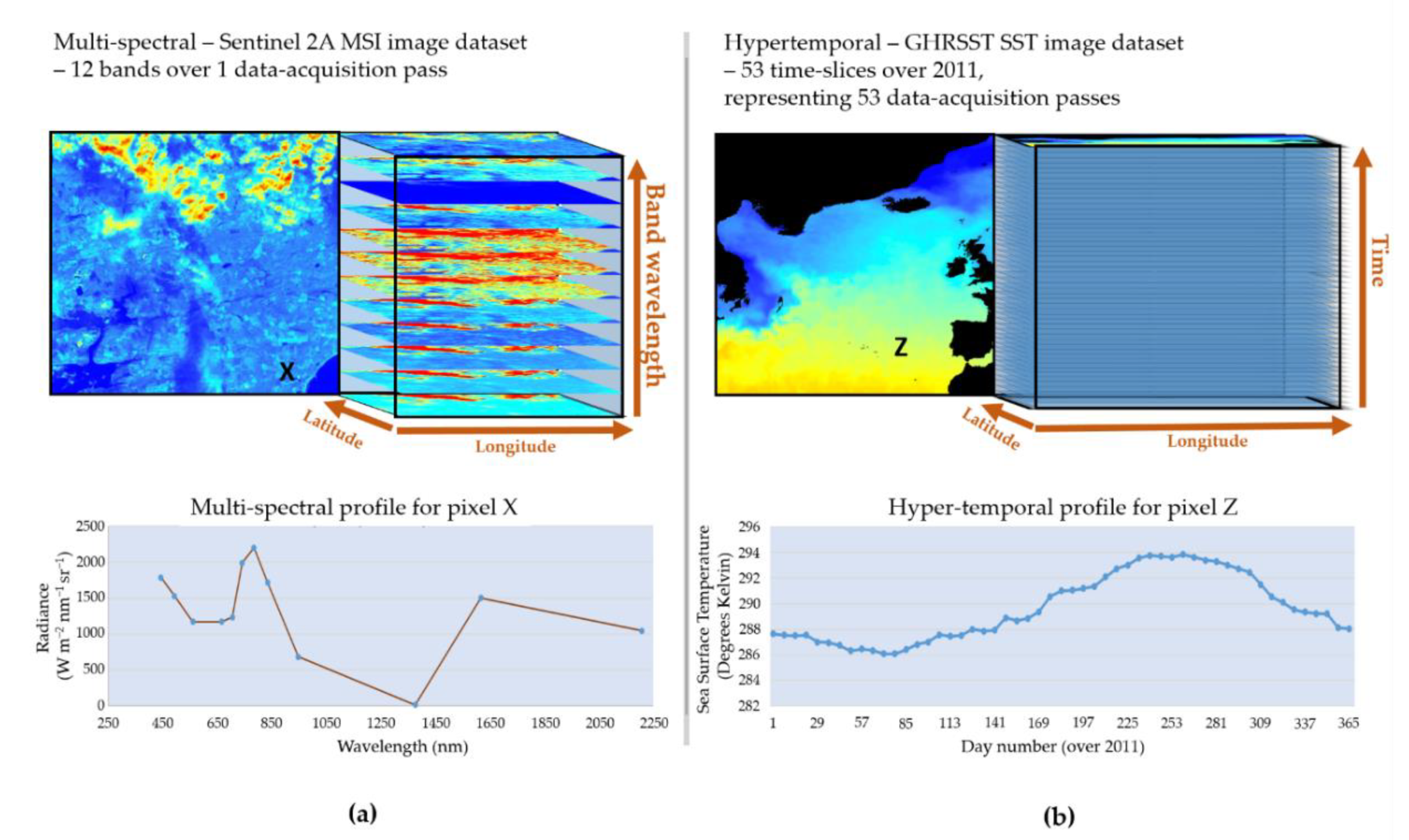
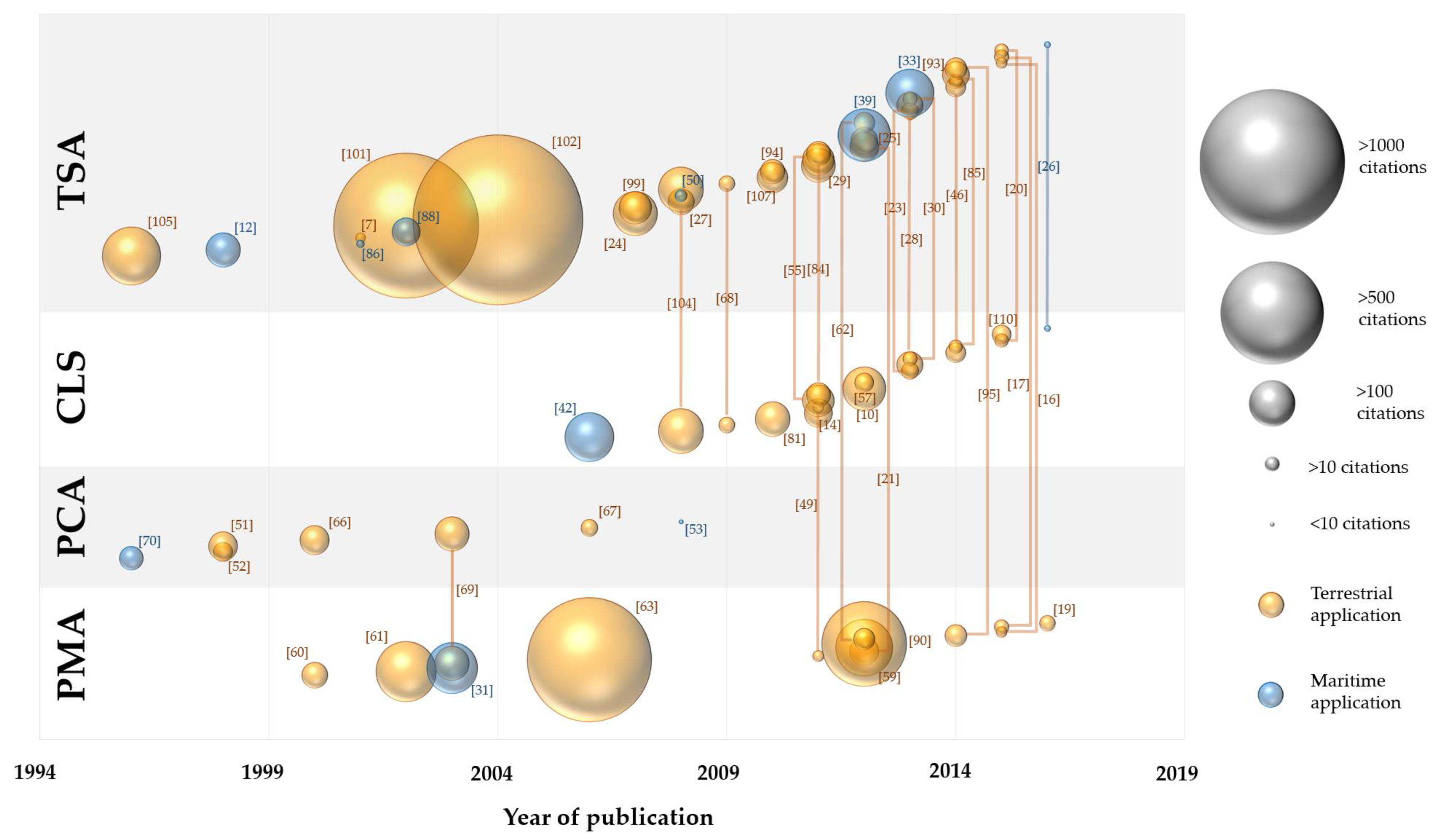

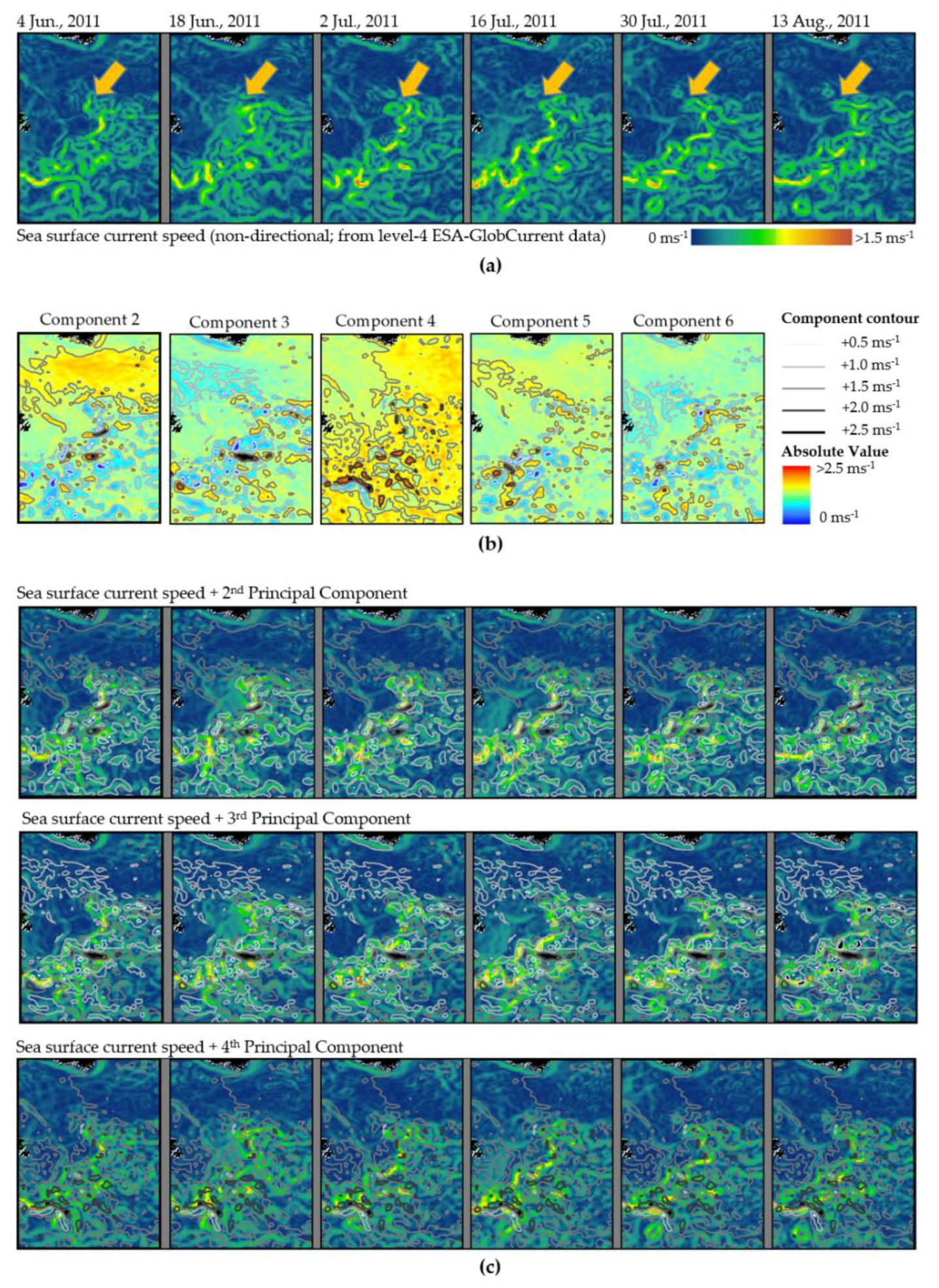
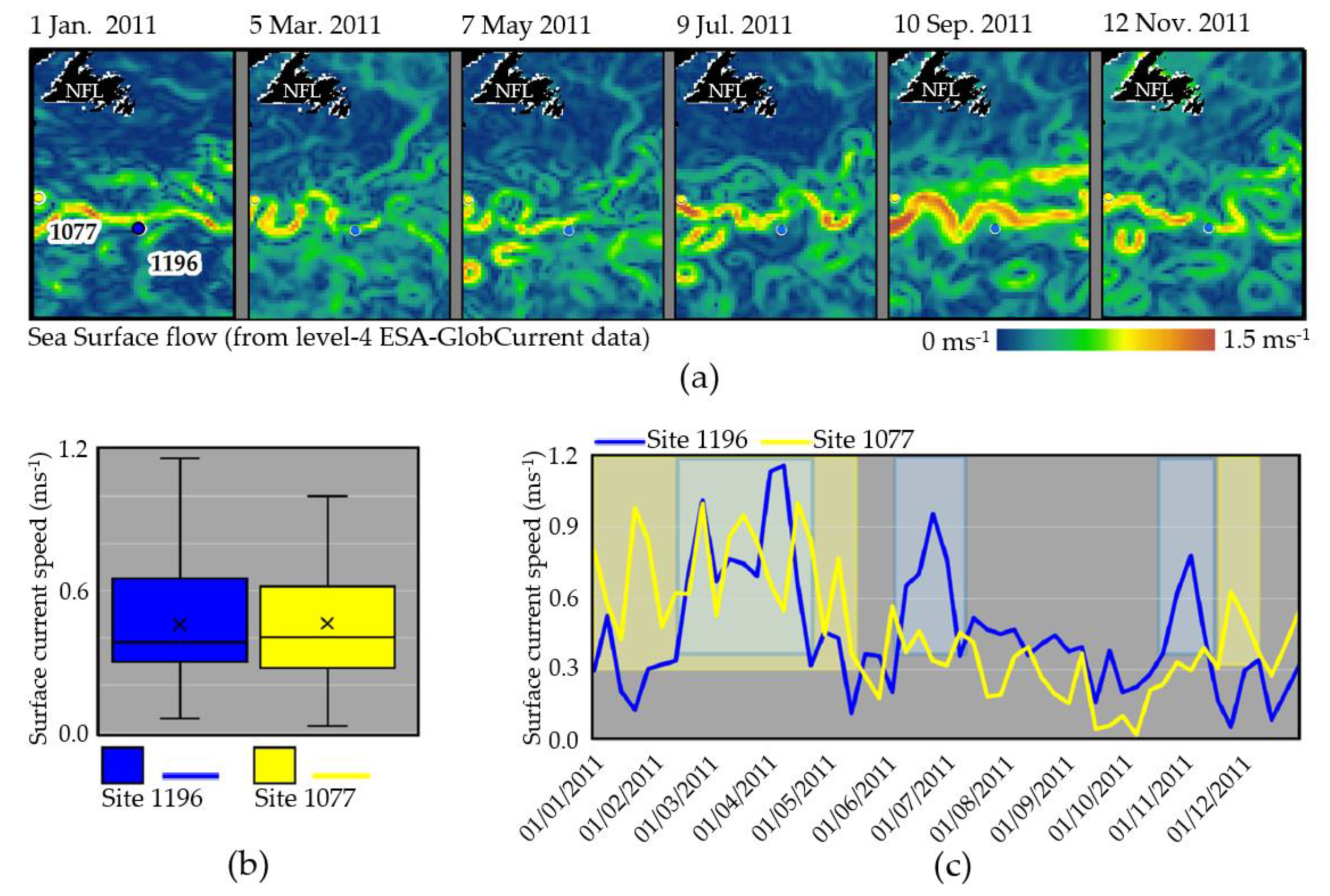
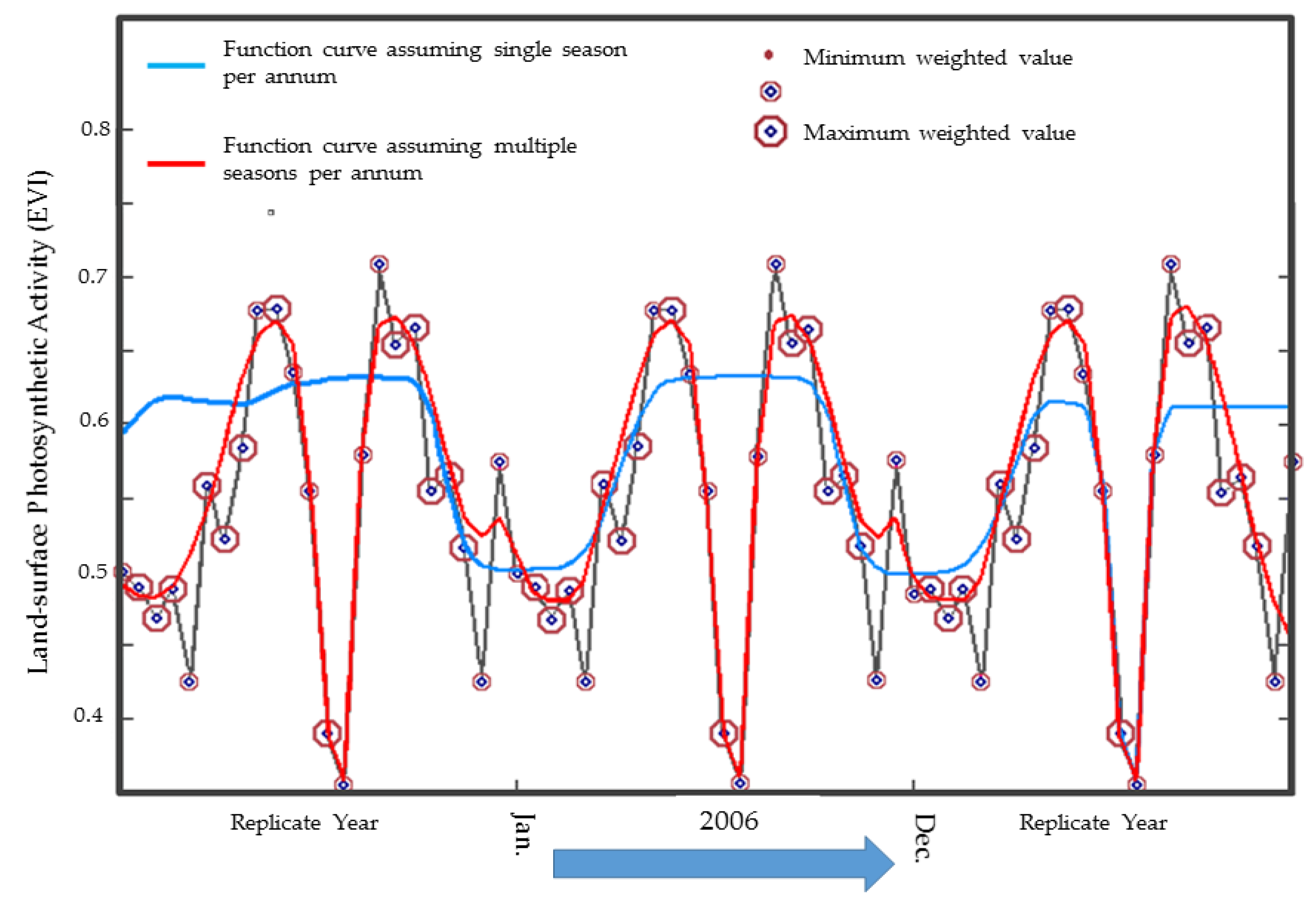
| Product | Parameter | Temporal Extent | Temporal Resolution | Spatial Resolution | Described In |
|---|---|---|---|---|---|
| GHRSST Global Ocean Sea Surface Temperature Multi Product Ensemble (GMPE) | Sea surface temperature | 2009–present | Daily | ~0.25° | Martin et al. [3] |
| MODIS Aqua Chlorophyll-a Concentration Level 3 | Sea surface photosynthetic activity | 2002–present | Daily | ~4 km2 | NASA [4] |
| Sea Ice Concentrations from Nimbus-7 SMMR and DMSP SSM/I-SSMIS Passive Microwave Data, Version 1 | Sea ice | 1978–2018 | daily | ~25 km2 | Cavalieri et al. (updated yearly) [5] |
| Global Wind Level-3 ASCAT 12.5 km Coastal Wind Product | Surface winds | 2012–present | daily | ~12.5 km2 | Vogelzang & Stoffelen [6] |
| Study (Authors, [Reference]) | Publication Year | Application | Methodologies Used | |||||||||||
|---|---|---|---|---|---|---|---|---|---|---|---|---|---|---|
| Primary | Secondary | Tertiary | ||||||||||||
| Pixel-Centred Measurement & Analysis (PMA) | Classification (CLS) | Principal Components Analysis (PCA) | Time-Series Analysis (TSA) | Fourier Series Analysis | Temporal Metrics & Phenology Metrics | Temporal Mixture Analysis | Wavelet Analysis (A.) | Post-Classification A. | Autocorrelation A. | Correlation A. | Loadings A. | |||
| Derksen et al. [51] | 1998 | Links between snow cover & atmospheric circulation | ✔ | ✔ | ✔ | |||||||||
| Derksen et al. [52] | 1998 | Links between snow cover & atmospheric circulation | ✔ | ✔ | ||||||||||
| Okkonen et al. [31] | 2003 | Mesoscale eddies | ✔ | |||||||||||
| LeDrew [32] | 2005 | Sea ice variability | ✔ | ✔ | ✔ | |||||||||
| Piwowar & Derksen [53] | 2008 | Sea ice concentration & atmospheric teleconnections | ✔ | ✔ | ✔ | |||||||||
| Piwowar [50] | 2008 | Sea ice concentration and characterising normals | ✔ | ✔ | ||||||||||
| Kleynhans et al. [54] | 2010 | Landcover classification & change detection | ✔ | ✔ | ✔ | |||||||||
| Piwowar [49] | 2011 | Characterising normal for vegetation vigour and anomalies | ✔ | ✔ | ||||||||||
| Salmon et al. [55] | 2011 | Settlement expansion, landcover change detection | ✔ | ✔ | ✔ | ✔ | ||||||||
| Ali et al. [56] | 2012 | Landscape ecology mapping | ✔ | ✔ | ✔ | |||||||||
| de Bie et al. [57] | 2012 | Landscape heterogeneity mapping, methodology development | ✔ | ✔ | ||||||||||
| Grobler et al. [58] | 2012 | Landcover classification & change detection | ✔ | ✔ | ||||||||||
| O’Connor et al. [25] | 2012 | Land surface phenology | ✔ | ✔ | ||||||||||
| Pittiglio et al. [21] | 2012 | Inputs for species distribution modelling | ✔ | ✔ | ||||||||||
| Ali et al. [28] | 2013 | Landcover, gradient mapping | ✔ | ✔ | ✔ | |||||||||
| Girma et al. [20] | 2015 | Species distributions | ✔ | ✔ | ✔ | ✔ | ||||||||
| Kleynhans et al. [16] | 2015 | Landcover change detection | ✔ | ✔ | ✔ | |||||||||
© 2019 by the authors. Licensee MDPI, Basel, Switzerland. This article is an open access article distributed under the terms and conditions of the Creative Commons Attribution (CC BY) license (http://creativecommons.org/licenses/by/4.0/).
Share and Cite
Scarrott, R.G.; Cawkwell, F.; Jessopp, M.; O’Rourke, E.; Cusack, C.; de Bie, K. From Land to Sea, a Review of Hypertemporal Remote Sensing Advances to Support Ocean Surface Science. Water 2019, 11, 2286. https://doi.org/10.3390/w11112286
Scarrott RG, Cawkwell F, Jessopp M, O’Rourke E, Cusack C, de Bie K. From Land to Sea, a Review of Hypertemporal Remote Sensing Advances to Support Ocean Surface Science. Water. 2019; 11(11):2286. https://doi.org/10.3390/w11112286
Chicago/Turabian StyleScarrott, Rory Gordon, Fiona Cawkwell, Mark Jessopp, Eleanor O’Rourke, Caroline Cusack, and Kees de Bie. 2019. "From Land to Sea, a Review of Hypertemporal Remote Sensing Advances to Support Ocean Surface Science" Water 11, no. 11: 2286. https://doi.org/10.3390/w11112286
APA StyleScarrott, R. G., Cawkwell, F., Jessopp, M., O’Rourke, E., Cusack, C., & de Bie, K. (2019). From Land to Sea, a Review of Hypertemporal Remote Sensing Advances to Support Ocean Surface Science. Water, 11(11), 2286. https://doi.org/10.3390/w11112286







